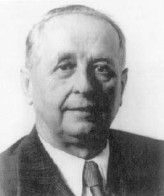

As a boy Hermann Weyl had already showed that he had a great talents for mathematics and science. After taking his high school graduation exam in 1904, he entered the University of Munich, where he took courses in both mathematics and physics. He then went on to study the same topics at the University of Göttingen, where his supervisor was Hilbert, and he graduated in 1908. He taught at Göttingen while he worked on his habilitation thesis.
During this period, Weyl made a reputation for himself as an outstanding mathematician who was producing work which was having a major impact on the progress of mathematics. He gave a lecture course on Riemann surfaces in session 1911-12 and out of this course came his first book which was published in 1913. It united analysis, geometry and topology, making rigorous the geometric function theory developed by Riemann. The book introduced for the first time the notion of a 2-dimensional differentiable manifold, a covering surface, and the duality between differentials and 1-cycles. Weyl's idea of a space also included the famous separation property later introduced and popularly credited to Hausdorff. It is rather remarkable that this 1913 text was reprinted in 1997.
From 1913 to 1930 Weyl held the chair of mathematics at Zürich Technische Hochschule. In his first academic year in this new post, he was a colleague of Einstein who was at this time working out the details of the theory of general relativity. It was an event which had a large influence on Weyl who quickly became fascinated by the mathematical principles lying behind the theory.
World War I broke out not long after, and being a German citizen he was conscripted into the German army in 1915, but the Swiss government made a special request that he be allowed to return to his chairship in 1916. In 1917 Weyl gave another course presenting an innovative approach to relativity through differential geometry. The lectures formed the basis of Weyl's second book which first appeared in 1918 This included the Weyl metric, which led to a gauge field theory. Also over this period Weyl also made contributions on the uniform distribution of numbers modulo 1 which are fundamental in analytic number theory.
He attempted to incorporate electromagnetism into the geometric formalism of general relativity. He produced the first unified field theory for which the Maxwell electromagnetic field and the gravitational field appear as geometrical properties of space-time. With his application of group theory to quantum mechanics he set up the modern subject. It was his lecture course on group theory and quantum mechanics in Zürich in session 1927-28 which led to his third major text published in 1928.
From 1923-38 Weyl evolved the concept of continuous groups using matrix representations. In particular his theory of representations of semisimple groups, developed during 1924-26, was very deep and considered by Weyl himself to be his greatest achievement.
From 1930 to 1933, Weyl held the chair of mathematics at Göttingen where he was appointed to fill the vacancy which arose on Hilbert's retirement. It is likely that he would have remained in Göttingen for the rest of his career, however the rise of the Nazis persuaded him in 1933 to accept a position at the newly formed Institute for Advanced Study in Princeton, where Einstein also went. Many other great books by Weyl appeared during his years at Princeton.
In 1951 Weyl retired from the Institute for Advanced Study at Princeton. After his retirement Weyl and his wife Ellen spent part of their time at Princeton and part at Zurich. He died unexpectedly while in Zurich. He was walking home after posting letters of thanks to those who had wished him well on his seventieth birthday when he collapsed and died.
His most famous quote is ``My work always tried to unite the truth with the beautiful, but when I had to choose one or the other, I usually chose the beautiful...''